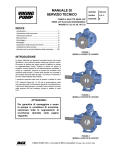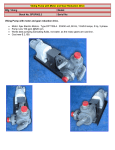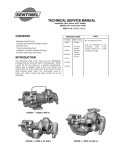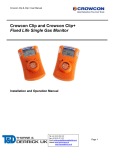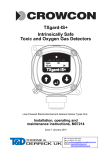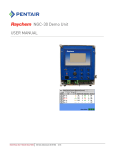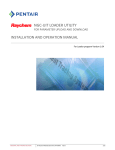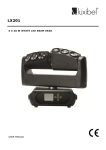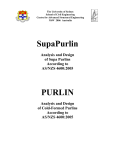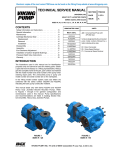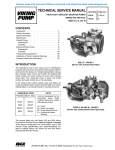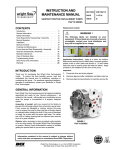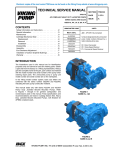Download PDF
Transcript
Electronic copies of the most current TSM issue can be found on the Viking Pump website at www.vikingpump.com TECHNICAL SERVICE MANUAL LVP series vane pumps SERIES LVP stainless steel SIZES 01, 02, 05, 08, 19 and 23 SECTION TSM 445 PAGE 1 of 11 ISSUE C CONTENTS Introduction . . . . . . . . . . . . . . . . . . . . . . . .1 Safety Information . . . . . . . . . . . . . . . . . . . . 2 Special Information . . . . . . . . . . . . . . . . . . . .3 Maintenance . . . . . . . . . . . . . . . . . . . . . . .3 Disassembly . . . . . . . . . . . . . . . . . . . . . . .5 Assembly . . . . . . . . . . . . . . . . . . . . . . . . .7 Mechanical Seal Replacement . . . . . . . . . . . . . .8 Installation of Bushings . . . . . . . . . . . . . . . . . .9 Pressure Relief Valve Instructions . . . . . . . . . . . 10 INTRODUCTION figure 1 MODELS LVP40017 AND LVP40027 The illustrations used in this manual are for identification purposes only and cannot be used for ordering parts. Obtain a parts list from the factory or a Viking representative. Always give a complete name of the part, part number and material with the model number and serial number of pump when ordering repair parts. The unmounted pump or pump unit model number and serial number are on the nameplate. This manual deals only with LVP Series Vane Pumps. Refer to Figures 1 through 16 for general configuration and nomenclature used in this manual. Pump specifications and recommendations are listed in Catalog Section 445, LVP Series Vane Pumps. ATTENTION ! To ensure safe handling and operating situations, please thoroughly review all of the warnings listed on the following page. figure 2 MODELS LVP41057 AND LVP41087 figure 3 MODELS LVP41197 AND LVP41237 VIKING PUMP, INC. • A Unit of IDEX Corporation • Cedar Falls, IA 50613 USA SAFETY INFORMATION INCORRECT INSTALLATION, OPERATION OR MAINTENANCE OF EQUIPMENT MAY CAUSE SEVERE PERSONAL INJURY OR DEATH AND/OR EQUIPMENT DAMAGE AND MAY INVALIDATE THE WARRANTY. This information must be read fully before beginning installation, operation or maintenance and must be kept with the pump. All installation and maintenance must be undertaken by suitably trained or qualified persons only. Symbol Legend : ! ! Danger - Failure to follow the listed precautionary measures identified by this symbol may result in serious injury or death. DO NOT OPERATE PUMP IF: – The front cover is not installed correctly. ! DO NOT place fingers, etc. into the pumping chamber or its connection ports or into any part of the drive train if there is ANY possibility of the pump shafts being rotated. Severe injury will occur. ! DO NOT exceed the pumps rated pressure, speed, and temperature, or change the system/duty parameters from those for which the pump was originally supplied, without confirming its suitability for the new duty. WARNING ! ! WARNING INSTALLATION AND OPERATION OF THE PUMP MUST ALWAYS COMPLY WITH HEALTH AND SAFETY REGULATIONS. A device must be incorporated into the pump, system, or drive to prevent the pump exceeding its stated duty pressure. It must be suitable for both directions of pump rotation where applicable. Do not allow pump to operate with a closed/blocked discharge unless a pressure relief device is incorporated. If an integral relief valve is incorporated into the pump, do not allow re-circulation through the relief valve for extended periods. The mounting of the pump or pump unit should be solid and stable. Pump orientation must be considered in relation to drainage requirements. Once mounted, shaft drive elements must be checked for correct alignment. Rotate pump shaft by at least one full revolution to ensure smoothness of operation. Incorrect alignment will produce excessive loadings and will create high temperatures and increased noise emissions. Do not use any drive arrangements which cause sideloading of the drive shaft. The installation must allow safe routine maintenance and inspection (to check for leakage, monitor pressures, etc) and provide adequate ventilation necessary to prevent overheating. Before operating the pump, be sure that it and all parts of the system to which it is connected are clean and free from debris and that all valves in the suction and discharge pipelines are fully opened. Ensure that all piping connecting to the pump is fully supported and correctly aligned with its relevant connections. Misalignment and/or excess loads will cause severe pump damage. Be sure that pump rotation is correct for the desired direction of flow. WARNING SECTION TSM 445 WARNING – Any guards are missing or incorrectly installed. – The suction or discharge piping is not connected. ! WARNING DO NOT INSTALL THE PUMP INTO A SYSTEM WHERE IT WILL RUN DRY (I.E. WITHOUT A SUPPLY OF PUMPED MEDIA). ISSUE C PAGE 2 OF 11 ! ! Warning - Safety instructions which shall be considered for reasons of safe operation of the pump or pump unit and/ or protection of the pump or pump unit itself are marked by this symbol. Pressure gauges/sensors are recommended, next to the pump suction and discharge connections to monitor pressures. Caution must be taken when lifting the pump. Suitable lifting devices should be used as appropriate. Lifting eyes installed on the pump must only be used to lift the pump, not pump with drive and/or baseplate. If pump is baseplate mounted, the base plate must be used for all lifting purposes. If slings are used for lifting, they must be safely and securely attached. For weights of bare shaft pumps refer to catalog. DO NOT attempt any maintenance or disassembly of the pump or pump unit without first ensuring that : – The pump is fully isolated from the power source (electric, hydraulic, pneumatic). –The pumping chamber, relief valve and any shaft seal support system are depressurized and purged. – Any temperature control devices (jackets, heattracing, etc) are fully isolated, that they are depressurized and purged, and components are allowed to reach a safe handling temperature. ! ! ! ! WARNING DO NOT attempt to dismantle a pressure relief valve which has not had the spring pressure relieved or is mounted on a pump that is operating. Serious personal injury or death and/or pump damage may occur. DO NOT loosen or undo the front cover, any connections to the pump, shaft seal housings, temperature control devices, or other components, until sure that such action will not allow the unsafe escape of any pressurized media. Pumps and/or drives can produce sound power levels exceeding 85 dB(A) under certain operating conditions. When necessary, personal protection against noise must be taken. Avoid any contact with hot parts of pumps and/or drives which may cause injury. Certain operating conditions, temperature control devices (jackets, heattracing, etc.), bad installation, or poor maintenance can all promote high temperatures on pumps and/or drives. When cleaning, either manually or by CIP method, the operator must ensure that a suitable procedure is used in accordance with the system requirements. During a CIP cleaning cycle, a pump differential pressure of between 30 and 45 psi is recommended to ensure suitable velocities are reached within the pump head. The exterior of the pump should be cleaned periodically. SPECIAL INFORMATION ROTATION: Viking LVP pumps are clockwise rotation (from shaft to end) standard, but they operate well in a clockwise or counterclockwise rotation, with some simple rearrangement of parts. The relief valve and internal plugs must be rearranged for counterclockwise rotation. See “Special Requirements for Reverse Rotation” details on page 7. SPECIAL MECHANICAL SEALS: Extra care should be taken in the repair of these pumps. Be sure to read and follow all special instructions supplied with your pump. Shaft rotation determines which port is suction and which is discharge. Viking LVP pumps have internal casing/head lubrication lines. Ensure these lines are setup correctly prior to operation. See “Assembly” section, page 7. DANGER ! PRESSURE RELIEF VALVES: 1. Viking pumps are positive displacement pumps and must be provided with some sort of pressure protection. This may be a relief valve mounted directly on the pump, an inline pressure relief valve, a torque-limiting device, or a rupture disk, or other method. 2. There are relief valve options available on those pump models designed to accept a relief valve. Options may include a return to tank relief valve. NOTE: Pump can be operated in reverse direction for short duration at low differential pressure to clean/flush out lines. 3. If pump rotation is to be reversed during operation, pressure protection must be provided on both sides of the pump. 4. The relief valve adjusting screw cap must always point towards suction side of pump. If pump rotation is reversed, remove pressure relief valve and turn end for end or use external pressure relief means. 5. Pressure relief valves cannot be used to control pump flow or regulate discharge pressure. For additional information on pressure relief valves, refer to Technical Service Manual TSM000 and Engineering Service Bulletin ESB-31. Before opening any Viking pump liquid chamber (pumping chamber, reservoir, relief valve adjusting cap fitting, etc.) Be sure: 1. That any pressure in the chamber has been completely vented through the suction or discharge lines or other appropriate openings or connections. 2.That the driving means (motor, turbine, engine, etc.) has been “locked out” or made non-operational so that it cannot be started while work is being done on pump. 3.That you know what liquid the pump has been handling and the precautions necessary to safely handle the liquid. Obtain a material safety data sheet (MSDS) for the liquid to be sure these precautions are understood. Failure to follow above listed precautionary measures may result in serious injury or death. MAINTENANCE Series LVP pumps are designed for long, trouble-free service life under a wide variety of application conditions with a minimum of maintenance. The following points will help provide long service life. Pumps that are mounted directly to the motor will need to be removed from the mounting bracket to perform mechanical seal maintenance or replacement. CLEANING PUMP: Keep the pump as clean as possible. This will facilitate inspection, adjustment, and repair work. STORAGE: If pump is to be stored, or not used for six months or more, the pump must be drained and a light coat of light oil must be applied to all internal pump parts. SUGGESTED REPAIR TOOLS: The following tools must be available to properly repair series LVP pumps. These tools are in addition to standard mechanics’ tools such as openend wrenches, pliers, screwdrivers, etc. Most of the items can be obtained from an industrial supply house. 1. Soft headed hammer 2. Allen wrenches (some mechanical seals and set collars) 3. Brass bar 4. Arbor press Apply grease to the pump shaft extension. Viking suggests rotating pump shaft by hand one complete revolution every 30 days to circulate the oil. Tighten all pump assembly bolts before putting the pump in service after being stored. SECTION TSM 445 ISSUE C PAGE 3 OF 11 VIKING VANE PUMP SERIES NUMBER KEY LVP41237UR Shaft Sealing: Design Standard: Drive Configuration: 4 = Mechanical Seal U = Inch M = Metric Mounting Arrangement: 0 = Motor Mount 1 = Footed M = Motor Mount D = Direct Drive R = Reducer Drive P = Purchased Reducer Material of Construction: 7 = 316 Stainless Steel Casing, Head, Rotor, Shaft LVP = Viking Low Viscosity Vane Pump Pump Sizes and Nominal Capacities: 01 02 05 08 19 23 Displacement of 19 GPM / 4 M³/Hr @ 1750 RPM Displacement of 39 GPM / 9 M³/Hr @ 1750 RPM Displacement of 79 GPM / 18 M³/Hr @ 1150 RPM Displacement of 100 GPM / 23 M³/Hr @ 950 RPM Displacement of 125 GPM / 29 M³/Hr @ 520 RPM Displacement of 160 GPM / 36 M³/Hr @ 520 RPM ASSEMBLY / DISASSEMBLY: MODEL LVP COMPONENT / CARTRIDGE MECHANICAL SEAL PUMPS ITEM NAME OF PART ITEM NAME OF PART ITEM NAME OF PART 2 Split Lock Washer (4 Req’d) (Use With Cartridge Seal Only) 30A Pipe Plug (3 Req’d) 46 Capscrew, for Valve (4 Req’d) LVP01 & LVP02 (8 Req’d) LVP05 thru LVP23 14 O-Ring Gasket for Seal Gland 30B Set Screw 5/16” x 1/2” lg. (2 Req’d) 47 Internal Relief Valve - High Temp (Complete) 15 Seal Gland 35 O-Ring Gasket for Head 48 Capscrew, for Foot (4 Req’d) (Optional on LVP01 & LVP02) 17 Capscrews for Seal Gland (4 Req’d) 36 Rotor and Shaft 49 Bolt on Foot (Optional on LVP01 & 02) 57 O-Ring Gasket for Head Cover Plate 58 Head Cover Plate 19 20 Sealing Option, Mechanical Seal or Cartridge Seal Flat Washer (4 Req’d) (Use With Cartridge Seal Only) 37 39 Vanes (4 Req’d) LVP01 & LVP02 (6 Req’d) LVP05 thru LVP23 Push Rods (2 Req’d) LVP01 & LVP02 (3 Req’d) LVP05 thru LVP23 25 Bushing (2 Req’d) 40 Head / Bushing Assembly 59 Capscrew, 5/16” NC 3/4” Lg. for Head Cover Plate (4 Req’d) 27 Casing / Bushing Assembly 43 Capscrew, 1/2” NC 1.00” Lg. for head (4 Req’d) LVP01 & LVP02 (5 Req’d) LVP05 & 08 (7 Req’d) LVP19 & 23 60 Disc (2 Req’d) 30 Pipe Plug - 1/4” (2 Req’d) 45 O-Ring Gasket for Relief Valve (2 Req’d) SECTION TSM 445 ISSUE C PAGE 4 OF 11 DISASSEMBLY 1. Mark the head and casing before disassembly to ensure proper reassembly. 2. Relieve pressure and drain fluid by removing the drain plug as shown in figure 4. 3.Remove the head from the pump. If the pump is furnished with a pressure relief valve, it need not be removed from casing or disassembled at this point. Refer to “Pressure Relief Valve Instruction,” page 10. 4.Remove the first carbon disc using caution not to break. See figure 5. 5.Remove the top vane from the rotor. Ensure the pushrod is not obstructing the vane being removed. Rotate the shaft and remove the other vanes in the same manner. 6. Remove the seal gland capscrews, slide packing gland out of the seal box, and remove the seal. 7.Loosen the mechanical seal setscrews for applicable seals. 8. Ensure the pushrods are not lodged in ports prior to removing the rotor. NOTE: When disassembling a pump with a cartridge seal, reference cartridge seal replacement beginning on page 8. 9. Carefully remove the rotor and shaft to avoid damaging the bracket bushing. One or more pushrods may fall out of the rotor upon removal from the casing. Take care to not jam the pushrods between the casing and rotor during the rotor removal. 10.Carefully remove the second carbon disc from the casing. If the casing disc is jammed, a small screwdriver or punch may be used as shown in Figure 5. Use the screwdriver to help guide the disc out of the casing cam bore as shown in Figure 6. 11.Press the bushings out of the casing and head if replacement is needed. For the head bushing, remove the head cover plate before pressing out the bushing. FIGURE 4 Location of drain plug. 12. Clean all parts thoroughly and examine for wear and damage. Check the bushings, carbon discs, vanes, pushrods and replace if necessary. Check all other parts for nicks, burrs, excessive wear and replace if necessary. DANGER ! Before opening any Viking pump liquid chamber (pumping chamber, reservoir, relief valve adjusting cap fitting, etc.) Be sure: 1. That any pressure in the chamber has been completely vented through the suction or discharge lines or other appropriate openings or connections. 2.That the driving means (motor, turbine, engine, etc.) has been “locked out” or made non-operational so that it cannot be started while work is being done on pump. 3.That you know what liquid the pump has been handling and the precautions necessary to safely handle the liquid. Obtain a material safety data sheet (MSDS) for the liquid to be sure these precautions are understood. Failure to follow above listed precautionary measures may result in serious injury or death. FIGURE 5 Removal of Disc. FIGURE 6 Use screwdriver to guide disc out. SECTION TSM 445 ISSUE C PAGE 5 OF 11 FIGURE 7 Install plug on discharge side. FIGURE 8 Line up disc hole with suction side. FIGURE 9 Rotor/shaft, vanes, pushrod installation. FIGURE 10 Vane installation. FIGURE 11 Plug head cap on discharge side. SECTION TSM 445 ISSUE C PAGE 6 OF 11 ASSEMBLY (for Standard Pump Construction, clockwise rotation) 1. Install the casing bushing. If the casing bushing has a lubrication groove, install the bushing with the groove at the 12:00 position in bracket. Refer to “Installation of Bushings,” page 9. 9.Install the head bushing. If the head bushing has a lubrication groove, install the bushing with the groove at the 12:00 position. Refer to “Installation of Bushings,” page 9. 2.Ensure the suckback/flush hole is plugged per figure 7. 10. Ensure the proper suckback/flush hole is plugged per figure 11. 3.Ensure the seal access holes are plugged unless they are being used for an external flush line. 4.Ensure the gauge ports are plugged unless being used for gauges or external flush lines. 11.Install the second disc outside of rotor. Ensure the hole in disc is on suction side. See figure 8. 12.Install the head O-ring onto the pilot on the head. 5. Install one carbon disc into casing, being careful to line up the disc hole with the suction side lubrication holes per figure 8. 13.Install the head onto the casing, being careful to not pinch the o-ring. 6. Coat the shaft with light oil. Install the pushrods and two or three vanes into the rotor as shown in figure 9. 15.Install the head coverplate O-ring. Install the head coverplate and tighten the capscrews evenly. 7. Install the rotor/shaft assembly into casing. Rotate rotor by turning the shaft so that one of the remaining open rotor slots is at the 12:00 position. Install a vane. Rotate to the remaining open slots and install the remaining vanes. 16. Lubricate and install the mechanical seal. See “Seal Installation,” page 8. 8.Ensure the grooves on the vanes are open in the direction of rotation and the rounded edge of the vanes are pointed out from the shaft as shown in figure 10. Turn shaft by hand to ensure the vanes and pushrods can move freely. 14.Tighten the head capscrews evenly. 17.Install the seal gland, tighten the capscrews evenly. DANGER ! Before starting pump, be sure all drive equipment guards are in place. Failure to properly mount guards may result in serious injury or death. DANGER ! Before opening any Viking pump liquid chamber (pumping chamber, reservoir, relief valve adjusting cap fitting, etc.) Be sure: SPECIAL REQUIREMENTS FOR REVERSE ROTATION 1. That any pressure in the chamber has been completely vented through the suction or discharge lines or other appropriate openings or connections. Viking LVP series vane pumps can be operated in reverse rotation after the following simple modifications: 2.That the driving means (motor, turbine, engine, etc.) has been “locked out” or made non-operational so that it cannot be started while work is being done on pump. 3.That you know what liquid the pump has been handling and the precautions necessary to safely handle the liquid. Obtain a material safety data sheet (MSDS) for the liquid to be sure these precautions are understood. Failure to follow above listed precautionary measures may result in serious injury or death. 1.Remove the relief valve and rotate 180 degrees. Reinstall the relief valve so the valve cap is pointing to the suction side of the pump. See page 10 for details on relief valve assembly/disassembly. 2. Remove the rotor/shaft assembly, taking care not to damage the mechanical seal or bushings. See “Disassembly” instructions on page 5. The mechanical seal will need to come off the shaft in the process. Inspect the seal for damage. Seal replacement may be necessary. See “Mechanical Seal Replacement,” page 8. 3. Remove the plugs (item 30B) in the casing and head and install them in the opposite side. 4. Remove both discs and reverse so that the hole is lined up with the suction side of the pump. 5. Re-install the rotor/shaft assembly and pushrods as described in the “Assembly” section. Install the vanes in the opposite direction shown in figure 10. The vane grooves should now be open in the new direction. Ensure the rounded edge of the vane will contact the casing. SECTION TSM 445 ISSUE C PAGE 7 OF 11 MECHANICAL SEAL REPLACEMENT This manual provides instructions for the three standard types of mechanical seals supplied on the following LVP vane pump models: LVP40017U,LVP40027U,LVP41057U,LVP41087U, LVP41197U,LVP41237U,LVP41017U,LVP41027U, LVP40017M,LVP40027M,LVP41057M,LVP41087M, LVP41197M,LVP41237M,LVP41017M,LVP41027M 1.Cartridge (Figure 12) 2. Elastomeric Bellows Type 52, 8-1 (Figure 13) 3. PTFE Wedge Type 9 (Figure 14) Identification of the seal type is an important step towards proper maintenance. For mechanical seal types not shown, see the Seal Instruction Drawing (SID) furnished with the pump or contact a Viking representative. SEAL REMOVAL Cartridge Type : Cartridge mechanical seals are designed so that they may be replaced with minimal pump and piping disassembly. 1. Remove any flush or barrier fluid tubes connected to the seal gland. 2.Loosen the setscrews on the seal collar to free the cartridge seal from the shaft. 3. Remove the gland capscrews and slide the cartridge seal off the end of the shaft. If the pump is to be disassembled further, refer to “Disassembly,” page 5. DANGER ! Before opening any Viking pump liquid chamber (pumping chamber, reservoir, relief valve adjusting cap fitting, etc.) Be sure: 1. That any pressure in the chamber has been completely vented through the suction or discharge lines or other appropriate openings or connections. 2.That the driving means (motor, turbine, engine, etc.) has been “locked out” or made non-operational so that it cannot be started while work is being done on pump. 3.That you know what liquid the pump has been handling and the precautions necessary to safely handle the liquid. Obtain a material safety data sheet (MSDS) for the liquid to be sure these precautions are understood. Failure to follow above listed precautionary measures may result in serious injury or death. SEAL INSTALLATION Cartridge Type : NOTE: Burrs left on the shaft can damage the O-ring on the seal sleeve during installation. Inspect the shaft for burrs and remove with a fine grade of emery cloth. 1.Clean the shaft and the face of the seal chamber. 2. Coat the shaft and O-ring in the inside diameter of the cartridge seal sleeve with a generous amount of light oil. Refer to Figure 12. FIGURE 12 Cartridge Mechanical Seal Elastomeric Bellows and PTFE Wedge Type : Elastomeric bellows and PTFE wedge seals generally require pump disassembly to be replaced (See “Disassembly,” page 5). 1. Loosen the nuts and remove the seal gland plate, seal plate holder, seal seat and seal gasket. 2.Loosen the setscrew in the set collar (bellows) or mechanical seal rotary member (wedge). NOTE: Piping and/or plugs will need to be removed to access the setscrews. 3. To complete the removal of the mechanical seal refer to Step 6 of “Disassembly,” page 5. SECTION TSM 445 ISSUE C PAGE 8 OF 11 3.Slide the cartridge seal on the shaft until it contacts the seal chamber face. 4.Insert the gland capscrews and secure the gland to the bracket face. NOTE: Turn the shaft several turns while the gland is loose to center seal; then tighten gland tight enough to compress the gasket. Tighten only enough to contain leakage and not to distort the gland. 5.Lock the cartridge seal drive collar to the shaft and remove or turn the centering clips out of the way so as to clear the drive collar. 6.Turn the shaft by hand or jog the motor to check the drive collar for runout. 7.Connect the flush line or vent the stuffing box for seals without the flush line until liquid is present on start up. NOTE: For maximum seal life, the flush line should be used. Elastomeric Bellows and PTFE Wedge Type : For complete pump assembly instructions, see “Assembly,” page 7. 1.Clean the rotor shaft and seal housing bore. Make sure they are free of dirt, grit and scratches. Gently radius the leading edge of the shaft diameter over which the seal is to be placed. NOTE: Never touch the mechanical seal faces with anything except clean hands or a clean cloth. Minute particles can scratch the seal faces and cause leakage. 2.Coat the shaft and the inside of the rotary member of the seal with a generous quantity of light oil. Grease is not recommended. 3.Start the rotary member on the shaft (including the seat collar and screws on the bellows seal) and ease over the shaft. NOTE: Some PTFE wedge seals are equipped with holding clips, which compress the seal springs. Remove the holding clips to release the springs after the seal is installed on the shaft. 4. For PTFE wedge seal, move the rotary member so the setscrews are directly below the seal access holes on the side of the bracket (See Figure 14). Tighten all setscrews securely to the shaft. 5. FOR “O-RING” GASKET TYPE MECHANICAL SEAL SEAT (BELLOWS SEAL): Lubricate the outer diameter of the O-ring seal gasket with oil. Flush the sealing faces of both rotary member and seal seat with oil and press the seal seat in to the bore until the back, unlapped face, is flush with the bore. Install the seal holder, seal plate, capscrews, and nuts and tighten securely. FOR “CLAMPED-IN” TYPE MECHANICAL SEAL SEAT (WEDGE SEAT): Flush the sealing faces of both the rotary member and seal seat with oil and install the seal seat and seal gasket over the end of the shaft against the machined bracket face. Install the other seal gasket, seal holder, seal plate, capscrews and nuts and fasten securely. NOTE: For component seals, LVP pumps come standard with an internal suction lubrication line. To complete assembly, refer to “Assembly,” page 7. FIGURE 14 PTFE Wedge Seal INSTALLATION OF BUSHINGS When installing the silicon carbide or carbon graphite bushings, extreme care must be taken to prevent breaking. Carbon graphite is a brittle material and easily cracked. If cracked, the bushing will quickly disintegrate. Using a lubricant and adding a chamfer on the bushing and the mating part will help in installation. The additional precautions listed below must be followed for proper installation. 1. A press must be used for installation. 2. Be certain the bushing is started straight. 3. Do not stop pressing operation until the bushing is in the proper position. Starting and stopping will result in a cracked bushing. 4.Check the bushing for cracks after installation. LVP bushings with interference fits must be installed by a shrink fit. 1.Heat the casing or head to 750ºF. 2.Install the cool bushing with a press. 3. If facilities are not available to reach 750ºF. temperature, it is possible to install with 450ºF. temperature; however the lower the temperature the greater the possibility of cracking the bushing. Consult factory with specific questions on high temperature applications. Refer to Engineering Service Bulletin ESB-3. FIGURE 13 Elastomeric Bellows Seal SECTION TSM 445 ISSUE C PAGE 9 OF 11 PRESSURE RELIEF VALVE INSTRUCTIONS DISASSEMBLY DANGER ! Before opening any Viking pump liquid chamber (pumping chamber, reservoir, relief valve adjusting cap fitting, etc.) Be sure: 1. That any pressure in the chamber has been completely vented through the suction or discharge lines or other appropriate openings or connections. FIGURE 15 Sizes LVP 01 and LVP 02 LIST OF PARTS 1. Valve Cap 6. Valve Body 2. Adjusting Screw 7. Valve Spring 3. Lock Nut 8. Poppet 4. Spring Guide 9. Cap Gasket 5. Bonnet 2.That the driving means (motor, turbine, engine, etc.) has been “locked out” or made non-operational so that it cannot be started while work is being done on pump. 3.That you know what liquid the pump has been handling and the precautions necessary to safely handle the liquid. Obtain a material safety data sheet (MSDS) for the liquid to be sure these precautions are understood. Failure to follow above listed precautionary measures may result in serious injury or death. Mark the valve and head before disassembly to insure proper reassembly. 1.Remove the valve cap. 2. Measure and record the length of extension of the adjusting screw. Refer to “A” on Figures 15 and 16. 3.Loosen the locknut and back out adjusting screw until the spring pressure is released. 4.Remove the bonnet, spring guide, spring and poppet from the valve body. Clean and inspect all parts for wear or damage and replace as necessary. FIGURE 16 Sizes LVP 05, 08, 19 and 23 LIST OF PARTS 1. Valve Cap 6. Valve Body 2. Adjusting Screw 7. Valve Spring 3. Lock Nut 8. Poppet 4. Spring Guide 9. 5. Bonnet SECTION TSM 445 10. ISSUE C Cap Gasket Bonnet Gasket PAGE 10 OF 11 TECHNICAL SERVICE MANUAL LVP series vane pumps SERIES LVP stainless steel SIZES 01, 02, 05, 08, 19 and 23 SECTION TSM 445 PAGE 11 of 11 ISSUE C ASSEMBLY Reverse the procedures outlined under “Disassembly,” page 10. If the valve is removed for repairs, be sure to replace in the same position. The relief valve adjusting screw cap must always point towards the suction side of the pump. If pump rotation is reversed, remove the relief valve and turn end for end. DANGER ! Before starting pump, be sure all drive equipment guards are in place. Failure to properly mount guards may result in serious injury or death. PRESSURE ADJUSTMENT If a new spring is installed or if pressure setting of the pressure relief valve is to be changed from that which the factory has set, the following instructions must be carefully followed. 1. Carefully remove the valve cap that covers the adjusting screw. 2.Loosen the locknut that locks the adjusting screw so the pressure setting will not change during operation of the pump. 3. Install a pressure gauge in the discharge line for the actual adjusting operation. 4.Turn the adjusting screw in to increase the pressure and out to decrease the pressure. 5. To test the valve setting, slowly close the line valve on the downstream side of the pump until the pressure relief valve opens and flow through the pump stops. This will show the maximum discharge pressure the valve allows at the current setting. Limit the amount of time in this condition to prevent overheating of the pump due to internal recirculation of the liquid. WARRANTY Viking warrants all products manufactured by it to be free from defects in workmanship or material for a period of one (1) year from date of startup, provided that in no event shall this warranty extend more than eighteen (18) months from the date of shipment from Viking. The warranty period for Universal Seal series pumps ONLY (Universal Seal models listed below) is three (3) years from date of startup, provided that in no event shall this warranty extend more than forty-two (42) months from the date of shipment from Viking. UNDER NO CIRCUMSTANCES SHALL VIKING BE LIABLE UNDER THIS WARRANTY OR OTHERWISE FOR SPECIAL, INCIDENTAL, INDIRECT, CONSEQUENTIAL OR PUNITIVE DAMAGES OF ANY KIND, INCLUDING, BUT NOT LIMITED TO, LOST OR UNREALIZED SALES, REVENUES, PROFITS, INCOME, COST SAVINGS OR BUSINESS, LOST OR UNREALIZED CONTRACTS, LOSS OF GOODWILL, DAMAGE TO REPUTATION, LOSS OF PROPERTY, LOSS OF INFORMATION OR DATA, LOSS OF PRODUCTION, DOWNTIME, OR INCREASED COSTS, IN CONNECTION WITH ANY PRODUCT, EVEN IF VIKING HAS BEEN ADVISED OR PLACED ON NOTICE OF THE POSSIBILITY OF SUCH DAMAGES AND NOTWITHSTANDING THE FAILURE OF ANY ESSENTIAL PURPOSE OF ANY PRODUCT. THIS WARRANTY IS AND SHALL BE VIKING’S SOLE AND EXCLUSIVE WARRANTY AND SHALL BE IN LIEU OF ALL OTHER WARRANTIES, EXPRESS OR IMPLIED, INCLUDING, BUT NOT LIMITED TO, ALL WARRANTIES OF MERCHANTABILITY, FITNESS FOR A PARTICULAR PURPOSE AND NON-INFRINGEMENT ALL OF WHICH OTHER WARRANTIES ARE EXPRESSLY EXCLUDED. See complete warranty at www.vikingpump.com. IMPORTANT In ordering parts for the pressure relief valve, always give the model number and serial number of the pump as it appears on the nameplate and the name of the part wanted. When ordering springs, be sure to give the pressure setting desired. VIKING PUMP, INC. • A Unit of IDEX Corporation • Cedar Falls, IA 50613 USA © 3/2013 Viking Pump Inc. All rights reserved












